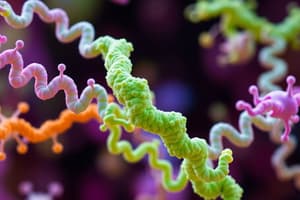Podcast
Questions and Answers
What does the yeast two-hybrid (Y2H) system primarily utilize to identify protein interactions?
What does the yeast two-hybrid (Y2H) system primarily utilize to identify protein interactions?
- A protein of interest as bait (correct)
- Confocal microscopy techniques
- Far western blot methods
- Antibodies directed against proteins
Which of the following is NOT mentioned as a tool for studying protein-protein interactions?
Which of the following is NOT mentioned as a tool for studying protein-protein interactions?
- Fluorescence resonance energy transfer (correct)
- Co-immunoprecipitation
- Gas chromatography
- Protein microarray
Why are protein-protein interactions considered difficult to predict?
Why are protein-protein interactions considered difficult to predict?
- There is a lack of advanced visualization techniques
- They are only observable in vitro
- The complexity of the interactions involved (correct)
- They are dependent on genetic mutations
Which biological aspect is significantly influenced by protein-protein interactions?
Which biological aspect is significantly influenced by protein-protein interactions?
What is a characteristic of protein complexes formed through protein-protein interactions?
What is a characteristic of protein complexes formed through protein-protein interactions?
In which era was immunoprecipitation primarily used for protein-protein interaction studies?
In which era was immunoprecipitation primarily used for protein-protein interaction studies?
Which of the following represents a common domain interaction type in protein-protein interactions?
Which of the following represents a common domain interaction type in protein-protein interactions?
What is one of the key reasons for studying protein-protein interactions in the context of biochemistry?
What is one of the key reasons for studying protein-protein interactions in the context of biochemistry?
What is the principle behind gel filtration chromatography?
What is the principle behind gel filtration chromatography?
What is the primary function of Far western blotting?
What is the primary function of Far western blotting?
In affinity chromatography, how are His-tagged proteins eluted from the column?
In affinity chromatography, how are His-tagged proteins eluted from the column?
What type of beads are used in co-immunoprecipitation to capture the protein complex?
What type of beads are used in co-immunoprecipitation to capture the protein complex?
What does protein microarray technology primarily allow researchers to do?
What does protein microarray technology primarily allow researchers to do?
What is the primary function of the Activation Domain (AD) in the Y2H method?
What is the primary function of the Activation Domain (AD) in the Y2H method?
Which statement correctly describes the purpose of the yeast two-hybrid assay?
Which statement correctly describes the purpose of the yeast two-hybrid assay?
In the context of protein interactions studied by the Y2H method, what does 'bait' refer to?
In the context of protein interactions studied by the Y2H method, what does 'bait' refer to?
What is one of the disadvantages of the yeast two-hybrid assay mentioned?
What is one of the disadvantages of the yeast two-hybrid assay mentioned?
Which of the following interactions is not typically involved in the assembly of virion particles?
Which of the following interactions is not typically involved in the assembly of virion particles?
What type of forces primarily mediate the interactions necessary for protein assembly processes?
What type of forces primarily mediate the interactions necessary for protein assembly processes?
Which protein reporter gene is used in the yeast two-hybrid assay to indicate successful transcription?
Which protein reporter gene is used in the yeast two-hybrid assay to indicate successful transcription?
What is required for strong couplings in protein-protein interactions?
What is required for strong couplings in protein-protein interactions?
Flashcards
Protein-Protein Interactions
Protein-Protein Interactions
Proteins interacting and binding together to form complexes, carrying out specific functions.
Yeast Two-Hybrid Assay (Y2H)
Yeast Two-Hybrid Assay (Y2H)
A method to identify proteins that physically interact with a protein of interest (bait) by using a yeast system.
Co-immunoprecipitation
Co-immunoprecipitation
An older method for discovering protein interactions, utilizing antibodies to pull down interacting proteins.
Protein Interactions Importance
Protein Interactions Importance
Signup and view all the flashcards
Far Western Blot
Far Western Blot
Signup and view all the flashcards
Protein Microarray
Protein Microarray
Signup and view all the flashcards
FRET
FRET
Signup and view all the flashcards
Confocal Microscopy
Confocal Microscopy
Signup and view all the flashcards
Yeast Two-Hybrid (Y2H)
Yeast Two-Hybrid (Y2H)
Signup and view all the flashcards
Bait protein
Bait protein
Signup and view all the flashcards
Activation Domain (AD)
Activation Domain (AD)
Signup and view all the flashcards
Prey ORF
Prey ORF
Signup and view all the flashcards
DNA Binding Domain (DBD)
DNA Binding Domain (DBD)
Signup and view all the flashcards
Protein-protein interaction
Protein-protein interaction
Signup and view all the flashcards
Reporter gene
Reporter gene
Signup and view all the flashcards
Proteome-wide survey
Proteome-wide survey
Signup and view all the flashcards
Gel Filtration Chromatography
Gel Filtration Chromatography
Signup and view all the flashcards
Far Western Blot
Far Western Blot
Signup and view all the flashcards
Co-Immunoprecipitation
Co-Immunoprecipitation
Signup and view all the flashcards
Affinity Chromatography
Affinity Chromatography
Signup and view all the flashcards
Protein Microarray
Protein Microarray
Signup and view all the flashcards
Study Notes
Protein-Protein Interactions Lecture Notes
- Course Description: This course provides an introduction to proteomics, genomics, and associated technologies, focusing on protein-protein interactions.
- Date: October 14, 2024
- Instructor: Dr. Manal Abouelwafa, Badr University in Assiut, Biotechnology Department
- Methods for identifying protein-protein interactions:
- Co-immunoprecipitation
- 2-hybrid assay
- Yeast two-hybrid assay
- Far western blot
- Protein microarray
- Fluorescence resonance energy transfer (FRET)
- Confocal microscopy
- Protein microarray
Central Dogma
- DNA → RNA → Protein: The central dogma describes the flow of genetic information from DNA to RNA to protein.
- Transcription: DNA is transcribed into RNA
- Translation: RNA is translated into protein.
- Replication: DNA is replicated
- Reverse transcription: An exception to the basic flow of the central dogma—RNA is used as a template to create DNA.
Gene Expression
- Transcription in Nucleus: DNA in the nucleus is transcribed into messenger RNA (mRNA)
- Splicing: Non-coding regions (introns) of mRNA are removed, leaving coding regions (exons)
- mRNA Export: Mature mRNA is exported to the cytoplasm
- Translation in Cytoplasm: mRNA is translated into a polypeptide chain of amino acids, forming a protein.
- Protein Folding: Polypeptide chains fold into their functional 3D structures.
Splicing
- Intron Removal: The pre-mRNA molecule contains both coding regions (exons) and non-coding regions (introns). Introns are removed during splicing.
- Exon Joining: Exons are joined together to form a mature mRNA molecule containing only coding information.
- GU and AG: These are conserved regions at the intron boundaries.
Introduction to Protein-Protein Interactions
- Importance: Protein-protein interactions are fundamental in many cellular processes. These include cell signaling, localization and trafficking, post-translational modifications, and viral replication.
- Complexity: Predicting protein interactions is challenging. Common patterns are domain-domain interactions and domain interactions with peptides.
- Multicomponent Complexes: Proteins often work together in complexes for specific functions ranging from simple dimers to complex systems like ribosomes.
- Higher Organisms: They tend to have more functional domains, and hence, more complex associations suggesting numerous potential interactions.
Biological Effects of Protein-Protein Interactions
- Inactivation/Suppression: PPIs can inactivate or suppress another protein.
- Novel Binding Sites: PPIs can create new binding sites for small molecules.
- Substrate Specificity: PPIs can modify the specificity of an enzyme for its substrates by altering binding partners
Identifying Protein-Protein Interactions
- Immunoprecipitation: A method used in the pregenomic era to identify protein interactions by using antibodies to isolate proteins.
- Yeast Two-Hybrid (Y2H) Assay: A post-genomic era method involving the cutting of a transcription factor into two parts (DNA-binding domain and activation domain) to find proteins that interact with each other.
- Bait and Prey Proteins: The protein of interest when used to assay other proteins.
Mechanisms of Interaction
- Non-Covalent: These are reversible interactions including van der Waals forces, hydrophobic interactions, electrostatic bonds, and hydrogen bonds.
- Strong Couplings: Accurate force fields are required for strong couplings.
Methods to Study Protein-Protein Interactions
- Gel Filtration: Separates molecules based on size in a porous matrix.
- Far Western Blot: Detects protein-protein interactions using antibodies.
- Affinity Chromatography: Isolates proteins based on their binding to specific ligands.
- Co-Immunoprecipitation: Isolates proteins/protein complexes from a cell extract based on antibody binding.
- Co-crystallization: Used to study protein-protein complexes through crystallography.
- Capillary Electrophoresis: Separates molecules by their charge and size.
- Biosensor: Measures binding interactions through changes in electrical properties.
- FRET (Fluorescence Resonance Energy Transfer): Measures protein-protein interactions by detecting energy transfer between molecules.
- Confocal Microscopy: Visualizes protein interactions in cells.
- 2-hybrid Assay: Protein interaction assay.
- Protein Microarray: High-throughput technique where proteins are arranged on a surface for interaction studies.
- Mass Spectrometry (Maspec): Analysis of protein molecules
- NMR (Nuclear Magnetic Resonance): Technique to study molecular structure and interactions based on magnetic properties of atoms.
- STRING (Search Tool for the Retrieval of Interacting Genes/Proteins): A database and analytical tool used in protein interaction research.
Gel Filtration Chromatography
- Size Exclusion: Molecules are separated based on their size in porous materials.
- Porous Polymers: The chromatography matrix is made from porous material to trap small molecules.
- Proteins Separated: Larger proteins elute first; smaller ones are trapped longer in the porous matrix.
Far Western Blot
- Protein Fractionation: Proteins are separated on SDS-PAGE.
- Blot to Membrane: Proteins are transferred to a membrane such as nitrocellulose or PVDF
- Overlay Protein: The immobilized proteins on the membrane are overlaid by a different protein solution.
- Antibody Detection: Antibodies specific to potentially interacting proteins are used to detect the interaction.
Co-Immunoprecipitation
- Sepharose Beads: Beads coated with protein A are used to isolate protein complexes
- Antibody Binding: Antibodies are designed to bind target proteins.
- Protein Precipitation: The antibody-protein complexes are precipitated with the beads.
- Western Blot (for analysis): The isolated protein complexes are separated and analyzed to confirm the interactions.
Affinity Chromatography
- Nickel/Cobalt Columns: His-tagged proteins can interact with nickel/cobalt immobilized resins.
- Imidazole Elution: The targeted proteins and their related proteins are released from the column by the addition of imidazole, causing a shift in equilibrium.
Protein Microarray
- High-Throughput: Used to track and determine protein interactions.
- Solid Support: Proteins are organized on microscope slides, membranes, beads, or microtitre plates.
- Protein Interactions: Interactions are detected by analyzing binding to each protein spot in the array.
Viral Assembly
- Structural Protein Concentration: Virion assembly begins when enough structural proteins are present in the cell.
- Components Come Together: Nucleocapsid formation is the first stage.
- Whole Particle: The process proceeds until the full virus particle is formed.
Studying That Suits You
Use AI to generate personalized quizzes and flashcards to suit your learning preferences.





